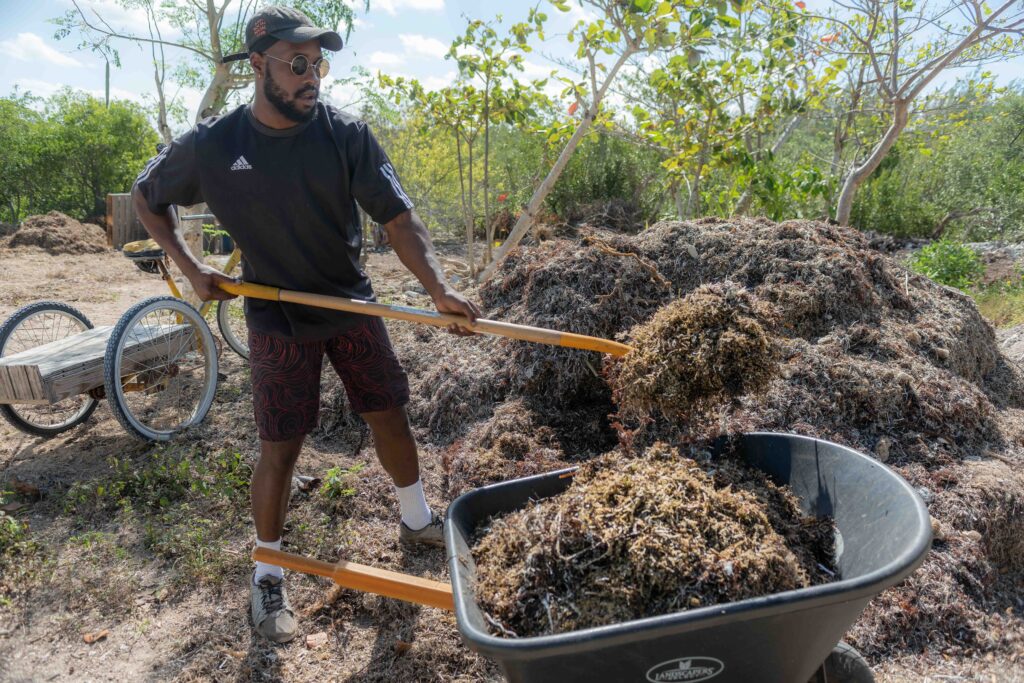
Did you know that nearly one-third of all food produced is either wasted or lost? That is about 1.3 billion tonnes of food wasted around the world each year, and this waste contributes to at least one-quarter of the annual greenhouse gas emissions around the world.
Locally, food waste presents a challenge in Eleuthera’s waste systems, as it is often mixed with other waste, such as plastics, metals, and electronic waste, which results in foul odors; attracts flies and rats, and produces methane; a potent greenhouse gas.
The Possibilities of Composting
The Island School has practiced composting since its inception to turn food waste into fertile soil, sequester carbon as a climate change mitigation strategy, and to model an integrated waste management system for green waste as an example of sustainable living on Eleuthera.
It is critical for our environment and sustainable development on Eleuthera to take a holistic approach to food waste management that emphasizes sorting green waste from solid waste using environmentally-conscious practices and also provides practical tips for individual community members to contribute by sorting their own waste.
At The Island School, food waste generated on campus is manually sorted into three categories (pigs, compost, and meat/bones) to separate food scraps for livestock feed, waste for compost piles to create soil, or meat scraps to breed Black Soldier Fly larvae that feed our chicken and tilapia on campus.
The Hierarchy of Food Waste helps us to contextualize the most favorable approaches of handling this valuable resource by the following means:
- Source reduction (most preferable): reduce the volume of surplus food generated
- Redistribution: donating food to those in need, or keeping and reusing food such as leftovers to avoid wastage
- Feed animals: diversion of food waste and scraps to feed livestock such as pigs or chickens
- Industrial Uses: utilizing waste food oils to create fuels, or digesting food scraps to create biogas energy
- Composting: converting food scraps into a soil amendment and organic fertilizer
- Landfilling (least preferable): burying or open-air burning of food waste; last and least favorable resort to disposal
By prioritizing low-tech processes like composting, we can actively divert organic food waste from our local dump sites and into more productive systems.
Why Should We Compost Food Waste?
Compost is the hummus-like product generated from the breakdown of dead organic matter and green waste. Beyond organic waste reduction; it serves as a catalyst for various environmental and community benefits. To make a good compost, there are a few basic ingredients necessary namely:
- Microbes – these are microorganisms (eg: bacteria, fungi) and macroorganisms (eg: earthworms, termites) that are responsible for digesting organic waste into small particles. These occur naturally or can be added.
- Nutrients – organic waste or “food”for the microbes in the form of Greens (eg: food, fruit or vegetable waste, animal manures, coffee grounds, grass clippings) or Browns (eg: woodchips, paper, cardboard, dried leaves, straw).
- Air & Moisture – as a compost pile is a living thing, it requires water and oxygen which are necessary for all life
Composting enriches the soil by recycling valuable nutrients and beneficial bacteria/fungi to foster healthier plant growth and enhancing the local soil structure. This, in turn, contributes to increased soil fertility for gardeners and local farmers, biodiversity and ecosystem resilience. By diverting organic waste from landfills, composting significantly reduces methane emissions and reduces the environmental pest pressure of flies and rats.

Tips on Backyard Composting
- Location and setup: select a spot that receives partial to full sun. You can utilize materials such as chicken wire, mesh or wood to frame your compost pile and protect it from unwanted animals.
- Balance Green and Brown Materials: Achieving the right balance between nitrogen-rich green materials (e.g. fruit and vegetable scraps, animal manures, seaweed) and carbon-rich brown materials (e.g. paper, dry leaves or woodchips). It is recommended to have a 3:1 volume ratio of carbon:nitrogen materials which is crucial for a healthy compost pile.
- Size Matters: start with a small and manageable pile; 3ft x 3ft x 3ft. Remember the smaller the particle size of the food, the easier it is to for the microbes to digest and speed up the composting process
- Aerate the Compost: Regular turning (1-2 times weekly) or stirring of the compost pile helps introduce air and oxygen, thus promoting aerobic decomposition, regulating its internal temperature and preventing unpleasant odors. Check the internal temperature of the pile, if it is hot, water and use a pitchfork and turn.
- Maintain Moisture Levels: Compost piles need moisture to facilitate decomposition. Ensure the pile stays damp but not waterlogged.
- Exclude Certain Items: Avoid adding meat, dairy, or oily foods to your backyard compost to prevent attracting pests and promote a balanced decomposition process.
The Island School’s commitment to composting represents a significant leap towards a more sustainable and eco-friendly future. By adopting the hierarchy of food waste, utilizing practical tips for backyard composting, and incorporating compost into community gardens, farms and landscapes, we can collectively address and solve our local issues with waste management.
